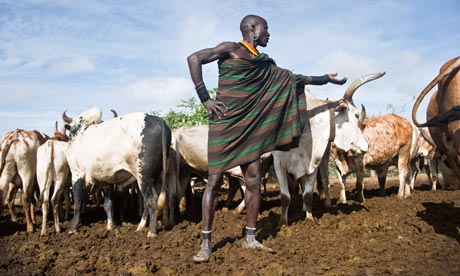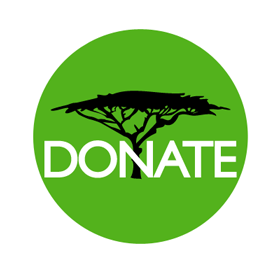Ugandan herders are well placed to adapt to global warming – but won’t be represented at the conference in Durban. Meanwhile their government, backed by EU cash, wants to force them to settle, reports John Vidal
Moding Ngolapus, a Jei herder in north-east Uganda. Photograph: Sven Torfinn
JohnVidal, 27th November 2011 (The Guardian, http://www.guardian.co.uk/environment/2011/nov/27/uganda-nomad-farmers-climate-change)
Three young Jei cattle herders firmly grasp a young white cow. Moding Ngolapus tightens a string round its scraggy neck, while his friend takes a roughly made bow, crouches and aims a blunt arrow from about 3ft away.
His first and second shots fail to even pierce the flesh, but the third finds an artery without severing it. The cow does not flinch as its blood squirts out and is collected in a bowl. Ngolapus pinches the wound, which clots quickly, then eases the string. It’s all very precise, conducted in silence and over in two minutes. The cow’s blood will be mixed with milk to make a liquid meal called ekacel.
This is Lobelai cattle camp in the heart of Karamoja province, north-eastern Uganda, a moving “city” of 10,000 or more cows which is home to about 300 mainly young Jei warrior nomads, who ceaselessly drive their herds across the 27,000 square miles of semi-arid land bordering Kenya and South Sudan.
The climate is harsh; water and pasture is scarce; for generations the Jei and other semi-nomadic clans, such as the Dodoth, have raided each other in constant low-level wars. Claiming all cattle as their own, they rustle – and in turn are raided – by fellow Karamojong groups as well as Turkana tribes from Kenya and the Toposa groups in South Sudan.
But now the Karamojong tribes’ days as nomads and warriors may be numbered. Ugandan government policies, backed by EU funds, are rapidly dismantling ancient pastoral systems just as climate change is biting with more frequent and intense droughts and rains.
More than 190 countries are preparing to meet on Mondayin Durban, South Africa, for the next round of UN climate talks. Africa’s estimated 20 million nomadic herders will not be directly represented in the talks, but their fate depends on attempts to reduce carbon emissions. If temperatures increase and droughts intensify in Africa’s drylands, as expected, their animals will be more at risk and conventional farming across vast areas could become impossible.
However, the skills these pastoralists have learned over centuries of adapting to these harsh environments could be of huge value to countries in the frontline of climate change. By constantly moving, they have learned to exploit areas where no one else could survive, and the millions-strong herds of livestock they manage have been shown to have immense economic potential.
According to the government, these “ill-educated” nomads, who regard cattle rustling as a sign of wealth and bravery, are primitive, aid-dependent and must be “sedentarised” – made to settle down and farm in a “modern way”.
Suspicions that Uganda has long wanted to eradicate pastoralism in order to clear the land for foreign-owned, mechanised farms, for conservation and for mineral exploitation, have been confirmed in a leaked letter from Janet Museveni, the president’s wife, who is the minister in charge of Karamoja affairs. Writing to the head of the EU delegation in Kampala, she said food aid money to the region, which regularly experiences hunger, is to be phased out, with the Karamojong families having to depend more on homegrown food. The EU has given Uganda £3.9m to fund a three-year development programme in Karamoja, with nearly all the money intended to make the nomads settle.
“We know the dangers of pastoralism outweigh its benefits. The people suffer because they are depending on old methods of work and their knowledge is never informed by input from anywhere else. Their children fail on education because they are always on the move. We cannot romanticise about nomadism as a way of life… it is a danger we have to fight like we fight all other social ills,” wrote Museveni.
In her letter, she says the nomadic way of life is “outmoded”, and she gives Israel as an example of a people who live in an arid land without being pastoralists. “As people learned to harness nature, they became civilised and settled down and developed slowly but surely. Life changed for the better,” she said.
The Ugandan government, according to Museveni, now plans to “exploit the potential of Karamoja”, a move which is expected to involve offering large tracts of Karamoja land to foreign corporations to grow biofuels, as well as designating more “conservation” and mining areas. This, say critics, will only increase conflict and hunger, force more young people to move into cities, and will destroy a rich way of life that has proved resilient and economically viable.
In fact, research by the International Institute for Environment and Development in London shows that nomadism is ideally suited to Africa’s semi-arid lands, especially as they are now experiencing increasing droughts, floods and unpredictable rains. It found that the nomadic cattle of west Africa, Ethiopia and Kenya produced more and better quality meat and generated more cash per hectare than “modern” Australian and American ranches.
“The latest pastoral production systems are one with the rangelands, ecologically inseparable and inherently sustainable, particularly in the face of climate change,” said Saverio Krätli, editor of Nomadic Peoples, the official journal of the Commission on Nomadic Peoples. “The assumption remains that pastoralism equals underdevelopment, and therefore pastoralists’ only move towards development is stepping out of pastoralism. In fact, it makes a substantial contribution to both national and regional economies,” he says.
Governments have steadily pushed Africa’s estimated 50 million semi-nomadic pastoralists from their traditional lands. Millions of hectares which were used to graze cattle in Ethiopia, Senegal, Mali, Chad, Kenya and other sub-Saharan countries have been lost to sedentary farming and conservation over the past 50 years, say the authors of Modern and Mobile, the institute study.
“Perceptions of their archaic life belie the fact that they have completely adapted to their environment,” says Pascal Pan Vuga, a British-trained Ugandan vet who has spent 17 years working with the Karamojong. “They love their cows, they protect them, worship them. They will give their lives for them and they name themselves after them. The cow and the human can be very close to each other. They have a remarkable culture, based on rituals, slaughter, observation and interpretation. They read their cows’ intestines to decide whether to move. It is surprisingly accurate. If they say something will happen, it usually does.”
Climate change, he says, is an added problem. “Traditionally, they have coping mechanisms to deal with an unreliable climate. Now they are seeing even less rain, and it compounds problems. There are so many factors undermining their life. Climate change is an aggravating but important one.”
Many pastoralists are now reluctantly moving towards settled farming. “Life has become very difficult and the weather is hard to predict,” said Paul Loyo, a Jei from Nasapiri village. “We do not know when a season will end or start, and when the rains come they are very heavy and destroy the crops. We have no guns to protect ourselves. The government should disarm all communities.”
But while pastoralists are able to adapt to climate change by moving great distances in search of better pastures, cultivators are largely unable to respond and do not know when or what to plant.
In Kenya, the semi-nomadic Maasai tribes near the border with Tanzania are also facing unreliable rains and floods.
“I have only 10 cows now and it’s not enough. We sell them to pay for schooling, shelter. They are life to us,” says Orumoi Evans. “Now I have to grow maize and vegetables. But pastoralism is more secure than cultivating. You cannot rely on the weather for growing food, but we do know where to go to find pasture.”

